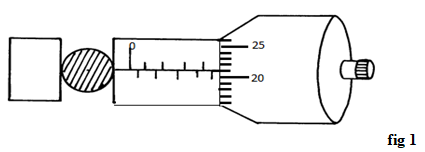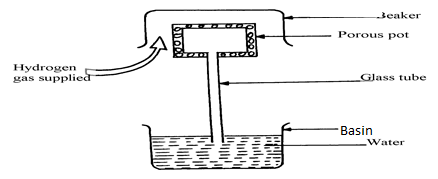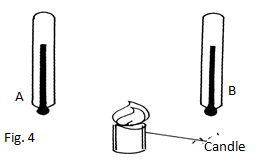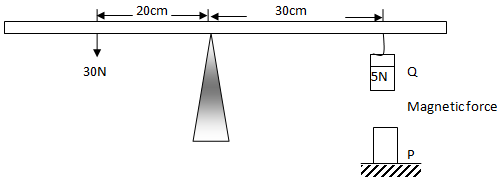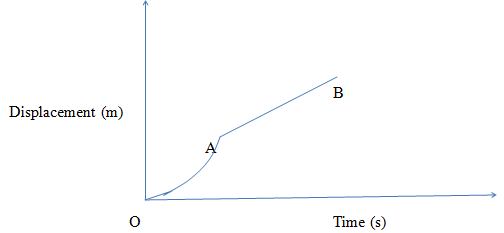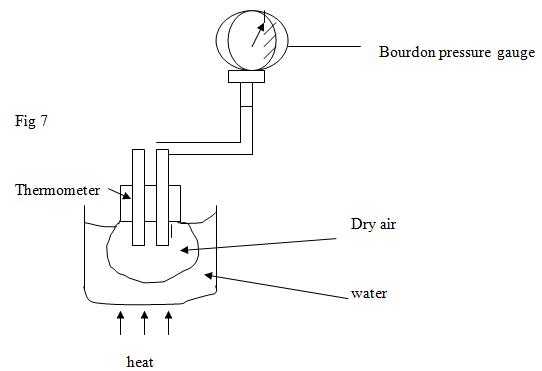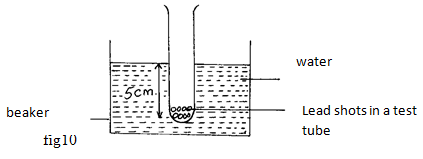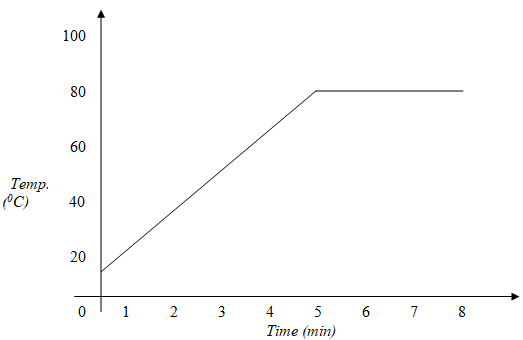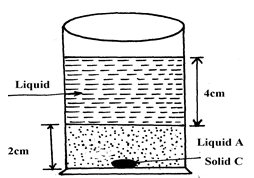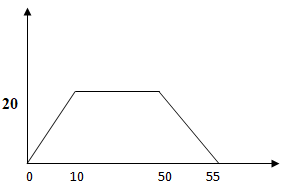- All working must be clearly shown.
- Electronic calculators, mathematical tables may be used.
- All numerical answers should be expressed in the decimal notations.
SECTION A (25 MARKS)
- A spherical ball bearing of mass 0.0024 kg is held between the anvil and spindle of a micrometer screw gauge. The reading on the gauge when the jaws are closed without anything in between is 0.11mm. Use this information and the position of the scale in the figure 1 below to answer the questions (a) and (b) below:
- What is the diameter of the ball bearing? ( 1 mk)
- Find the density of the ball bearing correct to 3 significant figures (2 mks)
- The diagram below shows a wire loop with two threads tied across it. The loop is dipped into a soap solution such that the soap film covers it as shown in fig 2
Fig 2
Region B is punctured such that the soap film in that section is broken. On the space alongside the diagram sketch the resulting shape of the wire loop. Give a reason for the shape. (2 mks) - The figure 3 below shows an arrangement to demonstrate diffusion through solids:-
The hydrogen gas is supplied for sometimes then stopped and the beaker removed. State and explain what is likely to be observed when the hydrogen gas supply is stopped (3 mks) - Figure 4 shows two identical thermometers. Thermometer A has a blackened bulb while thermometer B has a silvery bulb. A candle is placed equidistant between the two thermometers
State with a reason the observations made after some time(2 mks) - A car being driven on a horizontal straight road accelerates uniformly from O to 20m/s. In the first 10s. It continues at that speed for the next 40s and then decelerates to a stop in 5s. Sketch the velocity time graph for its motion. (2 marks)
- A uniform metre rule is balanced at its centre. It is balanced by the 30N, 5N and the magnetic force between P and Q. P is fixed and Q has a weight of 5N
Fig 5- Ignoring the weight of the metre rule, calculate the value of the magnetic force between Q and P ( 2 mks)
- Given that the lower end of Q is North pole, state polarity of the end of P facing Q. ( 1 mk)
-
- Give a reason why water is not suitable as a barometric liquid. (1 mk)
- Explain why a lift pump is unable to raise water from a borehole where the level of water is 20m below the ground level. (1 mks)
- The diagram below shows a mass of 12g hanged on a set of 6 identical springs.
When a mass of 12g was hanged on spring A alone, its extension was 5cm. Find the extension of the combination shown if each spring and each rod has negligible mass (2 mks)fig 6
- Sea water of density 1.04g/cm3 is being pumped into a tank through a pipe of uniform cross-sectional area of 3.142cm2. If the speed of water in the pipe is 5m/s, determine the mass flux in S.I unit. (2 mks)
- Below shows a displacement – time graph.
Describe the motion of the body between points:- OA…………………………………………………………………………… ( 1 mk)
- AB……………………………………………………………………………..( 1 mk)
- A quantity of air occupied 500cm3 at 15°C when the pressure was 76 cmHg. At what temperature would it occupy 460cm3 if the pressure was 85cmHg? (2 mks)
SECTION B (55 MARKS)
-
- State the pressure law for an ideal gas.(1 mark)
- The set up shows an arrangement to determine the relationship between temperature and pressure of a gas at constant volume.
- Describe how the measurements are obtained in the experiment (3 marks)
- Explain how the results from the experiment can be used to determine the relationship between temperature and pressure (2 marks)
- A bicycle tyre is pumped to a pressure of 2.2 x 105 pa at 23°c. After a race the pressure is found to be 2.6x105 pa. Assuming the volume of the tyre did not change, what is the temperature of the air in the tyre. (3 marks)
- Air is trapped inside a glass tube by a thread of mercury 240mm long. When the tube is held horizontally the length of the air column is 240mm.
Assuming that the atmospheric pressure is 750mmHg and the temperature is constant, calculate the length of the air column when the tube is vertical with open and down. (3 marks)
-
- An object is released to fall vertically from height of 100m. At the same time another object is projected vertically upward with velocity of 40m/s.
- Calculate the time taken before the objects meet (3mks)
- At what height do the objects meet? (2mks)
- A string of negligible mass has a bucket tied at the end. The string is 60cm long and the bucket has a mass of 45g. The bucket is swung horizontally making 6 revolutions per second. Calculate
- The angular velocity (2mk)
- The angular acceleration (2mks)
- The tension on the string (2mks)
- The linear velocity (1mk)
- An object is released to fall vertically from height of 100m. At the same time another object is projected vertically upward with velocity of 40m/s.
-
- State Archimedes’ principle. (1mk)
- The figure 9 below shows a rectangular buoy of mass 4000kg tethered to the sea-bed by a wire. The dimensions are 4m x 1.5m x 2.2m.
Calculate the :-
- Weight of sea water displaced by the buoy (density of sea water = 1100kg/m3) (3 mks)
- Upward force exerted on the buoy by the water. (1mk)
- Tension in the wire (2mks)
- A test tube of mass 10g and uniform cross-sectional area 4cm2 is partly filled with lead shots and floats vertically in water with 5cm of its length submerged.
Find the:-- Mass of the lead shots. (2mks)
- Length of the test tube that would be submerged in a liquid of density 0.75g/cm3. (2mks)
-
- State two differences between boiling and evaporation. (2 mk)
- 1200g of a liquid at 10°C is poured into a well-logged calorimeter. An electric heater rated 1KW is used to heat the liquid. The graph in fig 4 below shows the variation of temperature of the liquid with time.
Use the graph to answer the following questions:- What is the boiling point of the liquid? (1 mk)
- How much heat is given out by the heater to take the liquid to the boiling point? (2 mks)
- Determine the specific heat capacity of the liquid stating any assumptions made. (2 mks)
- If 50g of the liquid vapour was collected by the end of the 8th minute, determine the specific latent heat of vaporization of the liquid. (2 mks)
-
-
- State Newton’s second law of motion. (1 mk)
- A striker kicks a ball of mass 250g initially at rest with a force of 75N. if the foot was in contact with the ball for 0.10sec. Calculate the take off velocity of the ball. (2 mks)
- A bullet of mass 20g moving at 400 m/s strikes a block of wood of mass 3.5kg initially at rest. The bullet sticks into the block and the two move off together on a horizontal surface,where a frictional retarting force of 4N is acting between the block and surface.
- Determine the initial common velocity of bullet and wooden block. (2 mks)
- What distance does the block move before coming to rest? (3 mks)
- Two immiscible liquids are poured in an open container to the levels shown in the diagram below.
If the densities of the liquids A and B are 1g/cm3 and 0.8g/cm3 respectively and the atmospheric pressure 760 mmHg, find the total pressure acting upon solid C at the bottom of the container. (Take density of mercury to be 13.6g/cm3 and g = 10 N/Kg) (3 mks)
-
MARKING SCHEME
SECTION A (25 MARKS)
-
- (4.5 + 0.21) – 0.11 mm
= 4.6 mm ✓ - D = m/v
= 0.0024 ✓
4/3 × 22/7 × (2.3 × 10‾³)³
= 47, 091.13 kgm3
= 47100 kg/m3 (3 s.f) ✓
- (4.5 + 0.21) – 0.11 mm
-
Correct thread curving✓1 Surface tension is broken in region B and surface tension on side A and C Pulls the thread.✓1 - Water rises up the glass tube.✓
Hydrogen diffuses out the porous pot faster than air diffusing into the potcreating✓ partial vacuum (low pressure) hence atmospheric pressure pushes water upwards. - A shows higher temp reading.✓
Black is a good absorber ✓ of heat while silver reflects the heat away. -
-
- Σ ACM = Σcm
30 x 20 = 30 x F✓
F = 600 = 20N
30
Magnetic force = 20 − 5
= 15N✓ - South✓
- Σ ACM = Σcm
-
- It has low density✓ hence along column of water is supported by atmospheric pressure.
- The maximum height the can be raised is 10m since the pump✓ operates due to atmospheric pressure.
- EA = EB = EC = 12/3 × 12/12 = 1.67cm
eD = e = 12/2 × 5/12 = 2.5 cm ✓ Accept combined spring
e = 5 cm 5 cm constant method
Total 9.17 cm✓ - Mass flux = 3.142 x 10-4 x 5 x 1040 ✓
= 1.634 kg/s✓ -
- OA – increasing velocity ✓
- AB – constant velocity✓
- P₁V₁ = P₂V₂
T₁ T₂
T₂ = 85 × 460 × 288
76 × 500
= 296.3K
SECTION B (55 MARKS)
-
- The pressure of a fixed mass of a gas is directly proportional to its absolute temperature provided volume is kept constant.
-
-
- Initial temperature of the air is recorded and pressure noted as well.
- The air is heated using a water baths, the temperature readings and pressure are read at certain intervals.
- The value of temperature and pressure obtained are used to plot a graph of pressure against absolute temperature; A straight line through the origin is obtained showing that pressure is directly proportional it’, absolute temperature at constant pressure.
-
- P₁ = P₂
T₁ T₂
T₂ = 349.82k or 76.82°C - P₁V₁ = P₂V₂
750 x240 = (750 – 240)V₂
V₂ = 352.94mm
-
-
- Up motion h₁ = 40t – 5t2 ✓1
Down motion h₂ = 5t2
But h₁ + h₂ = 100m
100 = 5t² + −5t² + 40t✓1
t = 100 = 2.5 seconds ✓1
40 - hi = 40t – 5t²
= (40 x 2.2) – 5 (2.5)² ✓1
= 100 – 31.25
= 68.75m✓1 from the ground
- Up motion h₁ = 40t – 5t2 ✓1
-
- w = 2πf
= 2 × 22/7 × 6
= 37.7 radis✓ - a = rw2
= 0.6 x (37.72) ✓
= 853.42 radis✓ - F = ma
= 0.045 x 853.42✓
= 38.4N ✓ - v = rw
= 0.6 x 37.7
= 22.62 m/s ✓
- w = 2πf
-
-
- A body partially or totally immersed in fluid experiences an upthrust equal ✓ to the weight of the fluid displaced.
-
- Volume displaced = 4 x 1.5 x 1.2
= 7.2m3 ✓
Weight displaced = 7.2 × 1100 × 10 ✓1
= 79, 200N ✓ - Upthurst = 79,200 ✓1
- T = U – W
= 79,200 – (4000 x 10) ✓1
= 39 200 N ✓
- Volume displaced = 4 x 1.5 x 1.2
-
- Upthrust = weight of solid
(4 x 10-4 x 5 x 10-2) x 1000 x 10 = ( m × 10) + ( 10 × 10) ✓
1000 1000
m = 10g✓ - 0.2 = (4 × 10-4 × X) × 750 × 10 ✓1
x = 0.0667m
= 6.67cm ✓1
- Upthrust = weight of solid
-
Any two correct pair✓✓Evaporation Boiling 1 Takes place at all temp. Takes place at fixed temp. 2 At the surface of the liquid Through the liquid 3 Increases with decrease in pressure Decreased with decreases in pressure -
- 80°C ✓1
- p x t = 1000 x 5 x 60 ✓1
= 300,000J ✓ - Pt = mcθ
300,000 = 1200 x C x (80 – 10)✓
1000
c = 3571.43 J/kg/k✓1 - Pt = mLv
1000 x 3 x 60 = 50 x Lv ✓
Lv = 3.6 x 106 J/kg/k✓1
-
-
- A body continues in its state of rest or uniform motion in a straight line unless acted upon by an external force.✓1
- Ft = m (v-u)
75 x 0.1 = 25 (v − 0) ✓1
1000
V = 30 m/s ✓1
-
- M₁V₁ + M₂V₂ = (M₁V₂)v
V = 20 × 400
1000 (20/100 + 3.5) ✓
= 2.27 m/s✓ - a = F = 4
m (0.02 + 3.5)
= −1.136 m/s2✓
v² = v² + 2as
0 = (2.27)² – (2 x 1.136s) ✓1
s = 2.268 m ✓1
- M₁V₁ + M₂V₂ = (M₁V₂)v
- P total = s₁gh₁ + s₂gh₂ + Pa
= (1000 x 10 x 2/100) + (800 x 10 x 4/100 ) + ( 760/1000 × 10 × 13600)✓
= 200 + 320 + 103 360✓1
= 103 880 pa✓1
-
Download Physics Paper 1 Questions and Answers - Momaliche Joint Pre Mock Exams 2022.
Tap Here to Download for 50/-
Get on WhatsApp for 50/-
Why download?
- ✔ To read offline at any time.
- ✔ To Print at your convenience
- ✔ Share Easily with Friends / Students

